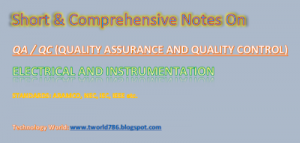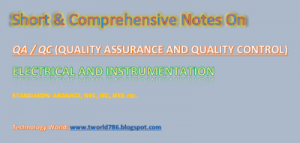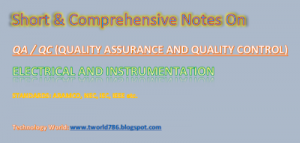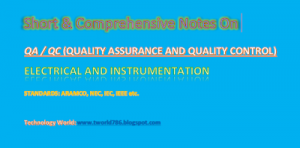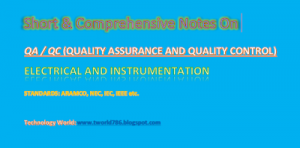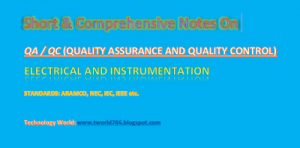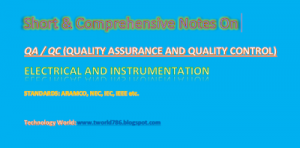Aramco Standard Electrical and Instrument Question Answers Part_2
1. What are inspection points for a cable tray installation?
Ans: Material check as per approved spec, size and type, tray’s hook-up, proper distance structure, tray to tray i.e. power/control/and signal/low voltage and high voltage, support and fixed strongly not shaking.
2. What are inspection points for field instruments with impulse tubing?
Ans: Materials inspection as per approved spec material, type and size, Installation as per Hook-up, check line route to avoid any obstruction, check tube bending, and check tube support, compression fitting or ferrules, and then pressure test (hydrostatic test) shall be done.
3. What are inspection points for a cable laying?
Ans: Material inspection as per approved materials, types and size, meggering, cable routing drawing, completion of cable route ( tray, conduit or trench etc ) and cable numbering (Tag), cable bending, use or proper tools and equipment for cable pulling.
4. What are inspection points for Junction Box and Marshalling cabinets?
Ans: Material Inspection, type, size as per approved specification, installation hook up for frame, bracket or stands, fixed properly means shaking free, Name Plate, and tag no.
5. What are standards methods or ferrules addressing to and from a Junction Box?
Ans: For to side only terminal’s address required which shall be close to terminal either side and complete information shall be of from side after or before as per left and right side.
6. What is final RFI? When it shall be raised up?
Ans: When the QA/QC department of contractor is satisfied that the work detailed in the construction RFI is completed, then request shall be submitted for inspection to the client QA/AC department.
7. What is schedule Q?
Ans: Schedule Q is an attachment to the contract, which is the provision of Quality Assurance and Control, Inspection and test plan.
8. What are the various levels of Inspection? Explain?
Ans: They are as following.
Level of Inspection for Materials:
A: Level 0 – Documents requirements only, no Inspection.
B: Level 1 – Inspection prior to shipping.
C: Level 2 – Minimum requirements, pre-inspection meetings, one or more unspecified “in progress” surveillance visits.
D: Level 3 – Same as level 2, except that “in progress” surveillance inspection shall be in regular basis.
E: Level 4 – Resident Inspection Continuously monitor the work.
Level of Inspection for construction phase:
A: Hold Point (H): The inspection activities will not proceed without the presence of inspection.
B: Witness Point (W): Inspection activities can be proceeding after issuing RFI.
C: Review (R): Verification of documentation (NMR) on its correctness as per spec and approved drawings.
D: Surveillance (S): Inspection has right to conduct random inspection of works.
E: Inspection (I) / Perform (P) / Test (T): construction can be proceeding to next phase without client inspection.
9. What is ITP’s? What are Hold and Witness Point?
Ans: ITP mean Inspection and Test Plan, details of work scope and required types of inspections.
Hold Point (H): is the level of inspection that client inspection must require through RFI and can’t be preceded until inspection is done by client.
Witness Point (W): is the level of inspection that inspection activity can be preceded without client inspection or if client is not available as per RFI Timing.
10. What is RFI? When an RFI will be raised?
Ans: Request for inspection (RFI), RFI shall be raised only when the status of the preliminary inspection is satisfactory, and the works (items) are Hold or Witness Point.
11. What is Cable tray and how is it identified separately for Electrical and Instrumentation?
Ans: Cable tray is the device used to provide support and protection to the laid cable in side the building or outside pipe rack.
12. What is Calibration and what is process calibration?
Ans: Checking / testing the equipment for its accuracy and serviceability are known as calibration.
Process calibration means carrying out calibration activity by following the adopted authorized method linked with standardization.
Process calibration means carrying out calibration activity by following the adopted authorized method linked with standardization.
13. What is the loop and how is the loop folder made?
Ans: Loop is the electro-mechanical presentation of the circuit concerning to flow of liquid or gas, alarm system, control valve operation and other specific for which field installation instrument involvement is considered. There are certain condition and requirements to be fulfilled to complete the loop check.
The list of attachments including drawing, check list and punch list and other listed documents are arrange in folder (loop wise) for having an easy access to carry out the loop check and final hand over of the project. That folder with all possible documents is known as loop folder.
The list of attachments including drawing, check list and punch list and other listed documents are arrange in folder (loop wise) for having an easy access to carry out the loop check and final hand over of the project. That folder with all possible documents is known as loop folder.
14. What is the specialty rather characteristics of loop check? How do you come to know that loop check is completed
Ans: a. Loop check is a clear blue print of a successful system functioning (activity wise).
b. This emphasis the serviceability of each instrument installed either in field or inside the building,
c. This exposes also the limitation of some systems functioning as per the attached filled punch list,
d. One of the ready documents for final hand over of a project on completion,
e. It is always two team’s operation-one will be on field and the other will be in the control room, After every successful completion of loop check it is marked with Red Colored Label bearing the date
of the loop check and the witnessing parties initial.
of the loop check and the witnessing parties initial.
15. What is the standard and what is the Standardization?
Ans: The standard means the authenticated documented instruction to be followed during execution
of any specific project for which it is made.
of any specific project for which it is made.
Standardization means the method of execution of certain standard, which is specific to the one
or more related activities in a project execution process.
or more related activities in a project execution process.
